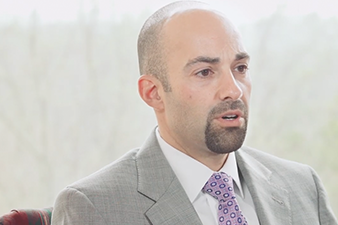
Q&A with Brad DeMent and Trey Robinson
In this follow-up to our workshop presented at the Shared Services and Outsourcing Network’s digital Shared Services for Finance and Accounting conference, experts Brad DeMent and Trey Robinson go deeper with insights, tips, and recommendations on how to lean into the finance delivery model during COVID-19 and beyond.
Q: Given the uncertain economic times and the desire to conserve cash, how do I advance my automation program?
A: The sudden decline in business activity has increased the urgency to conserve cash; however, we are beginning to see our clients re-start initiatives that had hit the pause button in March. Most are looking for smaller investments in automation that lend a quick fix or quick ROI vs. enterprise-wide mega-investments, like new enterprise resource planning (ERP) systems, says DeMent.
In this environment, thinking often shifts from strategic, long-term investment to tactical, short-term spend, but the need for automation certainly escalates. Those that had eliminated large amounts of manual work through automation are certainly reaping the benefits. Those that did not have incentive to re-ignite programs and start chipping away at smaller investments in technology, such as intelligent scanning, case ticketing systems, robotic process automation, and workflow, that produce a fix with a more affordable cash investment, says DeMent.
The “shelter-in-place” response to the pandemic forced companies to rapidly adapt to remote or virtual work practices. Many companies have talked about remote work for years but were unprepared to support this environment due to the absence of the simple video tools we are all now using. This will serve as a decision point to maintain this work environment, return to on-site presence, or perhaps some hybrid in between, says Robinson.
Further, the inability to get people together showcases the criticality of digitization in finance processes. Transaction processes still dependent on paper or physical document transfer were thrown into chaos during this time. Processes that still have paper or physical transfer should be automated through robotic process automation or other means of digitization, says Robinson.
Companies should take advantage of this time to make quick decisions on smaller investments in automation or collaboration tools, says DeMent.

Q: It was reported that many business process outsourcing (BPO) vendors struggled during the rapid transition to remote work. Should I be increasing or decreasing my emphasis on BPO for high-value finance activities?
A: We hear multiple opinions from financial leaders regarding BPO due primarily to the disruptive nature of the transition to virtual work during the pandemic response, says Robinson. Our clients tell us this is largely due to many centers being in areas of the world lacking sufficient infrastructure outside of the center to support virtual work, according to DeMent. Many BPO centers lacked the necessary planning for laptops or other equipment to take home. In many locations, workers’ home environments were not conducive to conducting professional operations.
Given this backdrop, it is critical to separate perception from reality when evaluating BPO arrangements. The perception when times are bad is that you don’t want this work occurring so far away from the home base—near-shore versus far-shore. Certainly, travel restrictions during this time exacerbated this perception. Logically, the reality is there’s not much difference between operating far-shore versus near-shore, especially with the technology available today. The perception is that companies don’t want to deal with problems a world away, according to DeMent.
The reality is that work has been successfully conducted far-shore for years—the current situation is more a business continuity planning issue; business continuity plans can be fixed. Many clients indicated that a pandemic response was built into existing business continuity plans. However, plans considered a slow-moving pandemic from region to region, which allowed for work to be migrated from one center to another. We encountered a fast-moving pandemic, unlike past recent experience, such that within two weeks the globe was affected. This meant there were very few unaffected centers available to receive migrating work, states DeMent.
Our clients tell us they had a few weeks of disruption while BPO providers determined how to manage remote workforces.
This experience highlights two key learnings:
| Companies need to be agile enough to bring back work if necessary. | ||
| Centers located in Tier 3 cities may pose more business continuity risk than larger cities due to inadequate infrastructure. Location and infrastructure could become more important criteria for site selection. |
When a crisis of this magnitude occurs, we expect BPOs will take even more precautions to mitigate future business continuity risks from events like a fast-moving pandemic. Companies should be cautious when considering moving away from a BPO strategy solely because a disruption such as this occurs. This is a learning opportunity—long term, we do not see this shifting the strategic view on how to work with BPOs, concludes Robinson.

Q: Is a remote finance workforce sustainable long term?
A: The general view we have heard from clients is that we will not return to normal as we saw it prior to the pandemic. Some are adamant that remote work will remain for the foreseeable future because the technology enables it and employees have been able to be productive, perhaps more productive than before. In addition, continuing the virtual work model could allow the reduction of real-estate footprints over time along with driving other savings organizationally, says Robinson.
An example where a remote team could be the “new normal” is a center of expertise focused on planning, budgeting, and reporting. The traditional view that these activities should be centralized geographically may no longer apply since we now have proven this work can be done with distributed talent. We recognize that, while these activities may be governed centrally, with distributed talent the work can be performed by virtual teams, adds DeMent.
While there seems to be a general appetite to continue working virtually as opposed to on-site, concern remains that a fully remote workforce could lead to a loss of community, negatively affecting retention rates. There is a sense that we will return to the office, maybe not in the way we used to, perhaps not every day, but there will be a return of some kind to the office to improve employee engagement and manage retention, suggests Robinson.
In the end, we believe our clients will need to determine what work can be done remotely and what work is better done in the office. In some cases where the work is team based, an office environment could be easier to manage. In other cases where there is a steady volume of work, which can be turned on or off, working remotely might be more appropriate, concludes DeMent.
Q: What new skills do finance leaders need to manage an increasingly remote workforce?
A: There is a strong sense that finance skill requirements were already changing before the onset of the pandemic. The rise of outsourcing arrangements, automation, and other technologies has caused more thoughtful consideration of the skill requirements for finance managers. Management’s focus is shifting over time, from managing manual, transaction-focused resources, perhaps performing accounts payable work, to managing BPO vendors and resources administering an automated workforce or robotic workforce, says DeMent.
A critical lesson learned from the sudden shift to remote work is the urgent need to maintain employee engagement. The ability to maintain a sense of community and esprit de corps among virtual employees requires different management skills. Without a sense of community, the risk is employees begin to feel like independent contractors instead of being part of something bigger. Determining how to manage virtual employees while building that sense of community is a practice we haven’t had to perform previously. Managing virtual employees represents a new area of skill development for finance leaders, according to Robinson.

Another changing skill requirement for finance leaders is understanding service expectations of front-line customers of finance. While shared services teams are largely able to operate remotely, front-line employees may not have the option. Being empathetic and flexible during service delivery will be increasingly required over the coming months. Prior to the pandemic, finance typically provided several interaction points for customers. For example, customers could contact finance through a call center or interact through the customer portal. Finance customers could readily request ad-hoc reporting or specialized analysis directly from finance rather than use a self-service portal. The pandemic may allow finance leaders to conduct campaigns to encourage its finance customers to utilize self-service portals. This effort will require more nuanced customer skills for finance leaders, concludes DeMent.
Q: Are finance models likely to become more global or more local over time?
A: We weren’t well prepared at the global level for some of the pandemic response decisions that needed to be made in the countries. As a result, this may drive a propensity for more regional or country autonomy in decision-making in the future. The ability to be nimble was important. Organizations have always needed to adapt to country-specific laws or regulations related to business operations, which often change. The rapidly changing regulations and edicts enacted by various levels of government in response to the pandemic highlighted the need for flexibility in our global delivery models to adapt to quickly changing, local circumstances, says DeMent.
To an extent, some of the added local decision-making autonomy will stick in service delivery models. However, we do not see this leading to less standardization of systems. Unnecessary customization of systems for local preferences would be counterproductive to the large investments made in ERP systems. Historically, there has been a strong emphasis in global models for standard policies around credit, collection terms, and travel, but there may be more flexibility in the future for local policy decisions that don’t impact system configuration, concludes DeMent.
Robinson agrees, we will continue to see more automation, which in some respects, will be location agnostic. The march toward automation and scale through centralization will continue; however, high degrees of automation and centralization could impact business continuity planning during times of crises. Many global business services struggle due to complex governance requirements. We are learning from the pandemic that even global business services, with rigorous business continuity plans and high degrees of centralization, must also have local decision-making ability. This does not shift the global business service model but emphasizes the agility needed at the local level to make decisions about policy, for example, establishing remote work capabilities, concludes Robinson.
About the Author
Brad DeMent is a partner at ScottMadden and leads the firm’s finance and accounting practice. Trey Robinson is a partner and leads the firm’s supply chain practice.


















































































